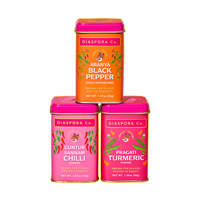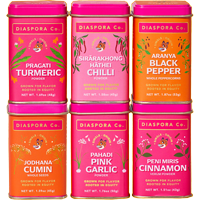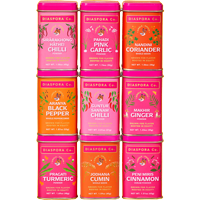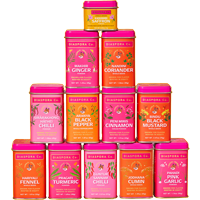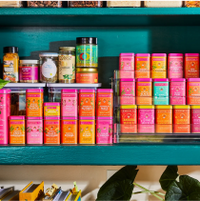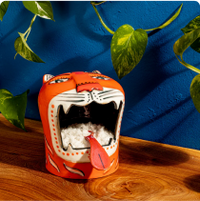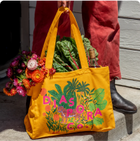It is 10am on a monsoon morning in August, and I am standing in a field of ginger saplings, hoping it does not rain. The plants are small, no more than knee height, planted in neat rows under trees of avocado, limes, neem, and custard apple. They look like gangly children lined up for school.
I watch women in brightly coloured saris, hair tied back and head covered, weeding around the ginger so the saplings get the light they need. Farther away, an older farm hand carefully unearths last year’s plants, to harvest the plump, juicy rhizomes. Pale yellow butterflies flutter about wild flowers, birds perch on branches, snapping up insects, bees add a gentle buzz to the air – signs of a healthy diverse biome, and testament to the farm’s regenerative growing practices. I snap open a rhizome, and the air fills with the heady scent of soil and ginger: earthy, warm, and floral. This is Basiya Ginger - an heirloom variety of ginger native to the region, and today, I am here to understand what makes it so special.
Diaspora’s fragrant Basiya ginger powder comes from Viva Van, a 200-acre farm in Madhya Pradesh, central India. The ginger plants are the understory of the food forest, which includes fruit trees like mulberry, mango, papaya, banana, lime, and custard apple. The farm also grows grains like amaranth and millets, legumes including peanuts and pigeon pea, and spices like turmeric, mustard, and curry leaves – all interspersed with towering forest trees that are native to the region. The sal trees are particularly beautiful, with their stately frame, broad leaves, and delicate white flowers, and I am reminded of the spiritual significance of the trees to the Gond tribe, one of the tribal communities that originally inhabited the region. Their presence also tells the history of the land: This region used to largely be a forest, inhabited by bears, porcupine, wild dogs, leopards, and tigers.
The forest is central to Viva Van’s growing philosophy, and the reason it is named so. "Viva as in ‘Long Live’,” explains Dimple, our farm partner, “and Van is Hindi for forest. So Viva Van is Long Live the Forest.” The farm is managed by Dimple and her siblings, Monita and Rahul, with the help of horticulturalist Subodh Thakre, who stays on the farm, and a team of experienced farmers that live in and around the region.
Interestingly, the Mehra family did not plan on growing food at all. “Our goal was forest restoration,” Dimple tells me as we walk past a nursery full of avocado and forest saplings. Over time, the family realised that restoration was expensive, and required far more resources than anticipated. To bring in revenue and to generate livelihood for the community around, they gradually began adding trees with commercial agricultural value. “Then we added plants like turmeric and ginger, to utilise the spaces between the trees, and keep the soil cool in the searing summer heat.”
I walk around the farm with Dimple and Rahul, past fields of peanuts, bordered with sweet lime trees, the cow shed, and the unit where their various additives are made, marvelling at the logistics of running a farm this size. The dung from the cows is used to make natural fertiliser; the urine is fermented for an inoculant of beneficial microbes; and the milk from the cattle is curdled into buttermilk and mixed with neem and other forest leaves to ward off pests. This kind of closed loop system, that recycles nutrients and organic matter within the farm, is a hallmark of regenerative farming valued for its low embodied energy, and for the biodiversity it brings.
Viva Van is in stark contrast with the many farms around. Most of the fields I saw on the drive here were planted with corn, cobs just beginning to form. There were a few modest homes, the occasional sal, neem and mango tree, but much of the land is occupied by densely planted hybrid yellow sweet corn. “Chhindwara is called Corn City,” I remember reading in a newspaper article. “It is the Number One crop of this region.”
But this was not always the case. At one point, Chhindwara used to grow a mix of wheat, soya bean, lentils, and millets. “Many grains and vegetables! And before that, it was a proper forest, with wild teak and chironji trees, deer and tigers,” a taxi driver informed me. “Now, it’s mostly yellow corn, because corn is easy.”
Easy is one way of putting it.
Corn is easier in some ways: The hybrid varieties of seeds grown by most farmers have a 60-day life cycle, compared to heirloom species of grain like wheat that take up to four months and require post-harvest processing. But it is also the manner in which it is grown: with liberal use of pesticide and fertiliser that negates the need to constantly weed, make compost, and tend to soil health. Much of this corn requires minimal quality control as it is used as animal feed, or processed into corn sugar and flour that go into a host of processed foods.
Growing in this way requires less attention – largely during sowing and harvest – allowing farmers to take on “city jobs” like working in factories. Why do they need additional jobs? Because like most farmers, in most parts of the world, the money earned by food growers is dismally low compared to the labour and resources required.
This is one of the most heart-breaking things about our current food system, and something I come upon again and again on farm visits. The truth is, many of the people doing the real work of growing food often earn the least. Add to this, the uncertainties of farming in the era of Climate Change, and I understand the lure of industrial farming methods. It is more reliable in the short run, and brings the financial security needed to look after one’s family, whether its school fees for children, or medical bills for aging parents.
With sustained use of pesticide and fertiliser, the vitality of the soil degrades, requiring greater amounts of additives, which further increase the cost of inputs for the farmers. The use of hybrid seeds also impacts seed sovereignty, meaning farmers are unable to save their own seed, and are reliant on large corporations at every stage of the way.
This is part of the reason that the Mehra family are so passionate about open-pollinated heirloom seeds, and natural farming techniques. The ginger they grow is a native variety, valued by the local farmers for its potent flavour and aroma. It is sowed in the month of June, at the start of the monsoon season, when the ground has plenty of water, and helps retain this moisture after the rains have gone.
Around February, when the ground has dried up but the summer heat is yet to achieve its full intensity, the ginger is harvested by hand, then washed, sliced, and sun-dried so the moisture evaporates, further intensifying the flavour. It is then milled and sieved by hand to remove the fibre, resulting in a smooth, fragrant spice powder that is rich in aromatic oils.
“We believe that natural foods are a great source of positivity, and this is not only true for us who consume these foods, but also for the soil and eco-system,” Dimple says. “Heirloom varieties take time, but they are more resilient. Natural farming is unpredictable, but the nutritive value of the food that it yields is higher, and better for the body.”
To truly nourish the body, is to truly nourish the Earth - this is something I find myself returning to again, and again on farm visits. How fortunate we are, to have access to food grown in this way, how vital it is that we support those that tend to the Earth, how beautiful food can be, for the mind, body, and heart, when it is grown with integrity.
So the next time you open a tin of our fragrant Basiya ginger, take a moment to inhale its floral notes, taste its earthy sweetness, and give thanks to the many creatures that have contributed to its creation.





